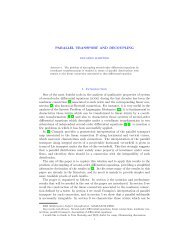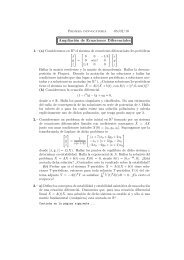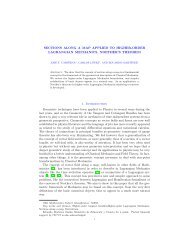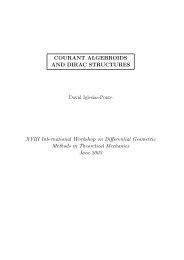TRANSFORMADA DE LAPLACE Estudiamos en este capítulo la ...
TRANSFORMADA DE LAPLACE Estudiamos en este capítulo la ...
TRANSFORMADA DE LAPLACE Estudiamos en este capítulo la ...
You also want an ePaper? Increase the reach of your titles
YUMPU automatically turns print PDFs into web optimized ePapers that Google loves.
<strong>TRANSFORMADA</strong> <strong>DE</strong> <strong>LAPLACE</strong> 15<br />
por <strong>la</strong> cu<strong>en</strong>ta para recorrer<strong>la</strong> no dep<strong>en</strong>da del punto desde el que <strong>la</strong> soltamos. A<br />
dicha curva se le conoce con el nombre de tautócrona.<br />
D<strong>en</strong>otemos por (x0,y0) un punto cualquiera de dicha curva, y calculemos el<br />
tiempo que le cuesta bajar hasta el orig<strong>en</strong>. Si consideramos <strong>la</strong> longitud del arco del<br />
a<strong>la</strong>mbre y d<strong>en</strong>otamos por v(s) <strong>la</strong> velocidad de <strong>la</strong> cu<strong>en</strong>ta cuando hemos recorrido s<br />
unidades de longitud sobre el a<strong>la</strong>mbre, <strong>en</strong>tonces el tiempo empleado es<br />
� L<br />
ds<br />
T (y0) =<br />
v(s) .<br />
La velocidad podemos re<strong>la</strong>cionar<strong>la</strong> con <strong>la</strong> altura por medio de <strong>la</strong> <strong>en</strong>ergía<br />
c = 1<br />
2 mv(x)2 + mgy,<br />
donde <strong>la</strong> constante c = mgy0, es <strong>la</strong> <strong>en</strong>ergía inicial (suponi<strong>en</strong>do que soltamos <strong>la</strong><br />
cu<strong>en</strong>ta <strong>en</strong> x0 con velocidad inicial v(x0) nu<strong>la</strong>). Despejando, obt<strong>en</strong>emos<br />
v(y) = � 2g √ y0 − y<br />
y sustituy<strong>en</strong>do llegamos a<br />
T (y0) = 1<br />
� L<br />
1<br />
√ √<br />
2g 0 y0 − y ds<br />
Finalm<strong>en</strong>te, si parametrizamos <strong>la</strong> curva por <strong>la</strong> variable y, es decir, los puntos de <strong>la</strong><br />
curva son de <strong>la</strong> forma (x(y),y), <strong>en</strong>tonces <strong>la</strong> longitud del arco también será función de<br />
<strong>la</strong> variable y, es decir, s = s(y). Cambiando <strong>la</strong> variable de integración y d<strong>en</strong>otando<br />
w(y) =ds/dy obt<strong>en</strong>emos<br />
0<br />
T (y0) = 1<br />
� y0<br />
w(y)<br />
√ √<br />
2g 0 y0 − y ds<br />
Posteriorm<strong>en</strong>te necesitaremos <strong>la</strong> re<strong>la</strong>ción explícita <strong>en</strong>tre <strong>la</strong> función w(y) y <strong>la</strong> parametrización<br />
x = x(y) de <strong>la</strong> curva, que concretam<strong>en</strong>te es<br />
w(y) = ds<br />
dy =<br />
0<br />
�<br />
1+<br />
� �2 dx<br />
.<br />
dy<br />
Una vez <strong>en</strong>contrada el tiempo como función de <strong>la</strong> altura desde <strong>la</strong> que se suelta<br />
<strong>la</strong> cu<strong>en</strong>ta, resolvamos el problema m<strong>en</strong>cionado, es decir, hal<strong>la</strong>r x(y) de manera que<br />
T sea constante, no dep<strong>en</strong>da de y0. Para ello debemos resolver <strong>la</strong> ecuación<br />
�<br />
� y0 w(y)<br />
2gT = √<br />
y0 − y dy<br />
que es un producto de convolución de <strong>la</strong>s funciones ν y g(y) = 1/ √ y, es decir,<br />
� 2gT =(w ∗ g)(y0)<br />
Al realizar <strong>la</strong> transformada de Lap<strong>la</strong>ce resulta √ 2gT/s = W (s)G(s), y como <strong>la</strong><br />
transformada de g(t) = 1/ √ t es G(s) = � π/s, obt<strong>en</strong>emos finalm<strong>en</strong>te<br />
W (s) = � 2gT 1<br />
�<br />
s<br />
s π = � 2gT 1<br />
√ =<br />
πs � 2g T<br />
�<br />
π<br />
π s .<br />
La transformada inversa de esta función es<br />
w(y) = � 2g T 1<br />
√ .<br />
π y<br />
Sustituy<strong>en</strong>do <strong>en</strong> <strong>la</strong> re<strong>la</strong>ción w(y) =<br />
�<br />
1+<br />
� �2 dx<br />
dy , y l<strong>la</strong>mando a = gT 2 /π2 se obti<strong>en</strong>e<br />
dx<br />
dy =<br />
�<br />
2a<br />
− 1.<br />
y
















